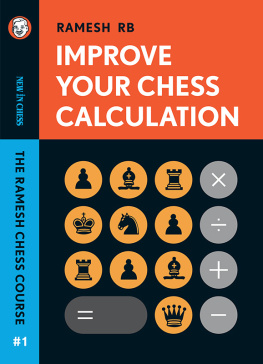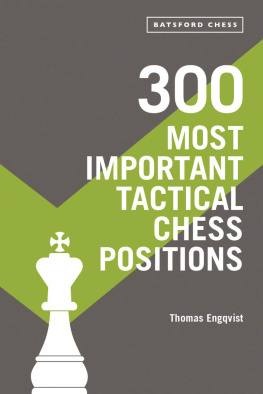Table of Contents SIMPLE SOLUTIONS WIN THE MATERIAL TACTICS ACCORDING TO SMYSLOV UNEXPECTED OPPORTUNITY MAKE A CHOICE EVALUATE IF THE MOVE IS POSSIBLE ANSWER THE QUESTION PLAY BETTER THAN CHAMPIONS COMPLICATED CALCULATION PRACTICAL EXERCISES Tadej Sakelek Adrian Mikhalchishin The Power of Tactics Volume 3 Calculate like Champions  Responsible editor Csaba Balogh Cover designer Piotr Pielach Drawing by Ingram Image Typesetting i-Press www.i-press.pl First edition 2020 by Chess Evolution The Power of Tactics. Volume 3: Calculate like Champions Copyright 2020 Chess Evolution All rights reserved. No part of this publication may be reproduced, stored in a retrieval system or transmitted in any form or by any means, electronic, electrostatic, magnetic tape, photocopying, recording or otherwise, without prior permission of the publisher. ISBN: 978-615-5793-23-3 All sales or enquiries should be directed to Chess Evolution 2040 Budaors, Nyar utca 16, Hungary e-mail: info@chess-evolution.com website: www.chess-evolution.com Printed in Hungary Key to symbols
Responsible editor Csaba Balogh Cover designer Piotr Pielach Drawing by Ingram Image Typesetting i-Press www.i-press.pl First edition 2020 by Chess Evolution The Power of Tactics. Volume 3: Calculate like Champions Copyright 2020 Chess Evolution All rights reserved. No part of this publication may be reproduced, stored in a retrieval system or transmitted in any form or by any means, electronic, electrostatic, magnetic tape, photocopying, recording or otherwise, without prior permission of the publisher. ISBN: 978-615-5793-23-3 All sales or enquiries should be directed to Chess Evolution 2040 Budaors, Nyar utca 16, Hungary e-mail: info@chess-evolution.com website: www.chess-evolution.com Printed in Hungary Key to symbols
| = | Equality or equal chances |
| White has a slight advantage |
| Black has a slight advantage |
| White is better |
| Black is better |
| + | White has a decisive advantage |
| + | Black has a decisive advantage |
| unclear |
| with compensation |
| with counterplay |
| with initiative |
| with an attack |
| with the idea |
| only move |
| N | novelty |
| ! | a good move |
| !! | an excellent move |
| ? | a weak move |
| ?? | a blunder |
| !? | an interesting move |
| ?! | a dubious move |
| + | check |
| # | mate |
preface The middlegame is the most important part of the game, as the majority of encounters are decided there. We know that sometimes it is difficult to divide strategy and tactic, as they both have the same aim to win the game. Strategy is the more difficult subject, because it involves planning and structures: tactics helps to conduct these plans in the fastest way.
In olden times it was the division of the style of players TACTICAL and STRATEGIC. In modern chess this division practically does not exist, as every top player is able to operate with all tools. Still we can name as tactical-style players such great attackers as Mikhail Tal, Rashid Nezhmetdinov, Albin Planinc and Victor Kupreichik. Perhaps, in reality, their strategy was a bit simpler with the aim of direct attack on the opponents king, and not simply attacking some weakness on the queenside, for example. During the times of the Soviet chess school, the label TACTICIAN led to an underestimation of attackers. But we all know that the chess public enjoy attacking play and admire great attackers much more than pure, boring strategists.
Of course, this attitude is connected with the openings. For example, in gambits, players have to consider many more tactical elements than in, for example, the Carlsbad variation of the Queens Gambit. Likewise, the Sicilian Defence with kings castled on different sides and fierce pawn attacks on both flanks; here tactics and sacrifices are in the air as the strategy was prepared from the first moves of the openings. There are many valuable books on tactics, and many authors have presented classifications of tactical motifs and themes. But some of them are too academic in modern times we require a much more practical education. For this reason, nowadays different test books are becoming very popular.
Calculate Like Champions is the third book in the series The Power of Tactics . In this third volume, the authors continue to develop their ideas from the first two book Tactics According to Smyslov and the Become a Tactical Wizard where they explain that in chess there are four main tactical elements (check, pin, double attack and unprotected pieces). They have added very instructive exercises revolving around mating attacks and queen sacrifices to achieve different goals and, in my opinion an extremely important element, defensive tactics. IGM Aleksandr Beliavsky introduction Tactics, including the calculation of variations, is the most important part of chess. Knowledge of openings, middlegames, endgames, strategy, technique, realization of the advantage and similar is also extremely important. But all this knowledge doesnt help us if we dont calculate properly.
There are many great books on tactics, wherein the authors have assembled different tactical motifs and elements. This area of chess is more or less very well covered in literature. This begs the question, why then have we decided to write and publish our book? Firstly, during all these years that we have been working as chess coaches, we collected a huge amount of instructive material, and it made sense to us to share it with our readers as well. Secondly, you can never have enough tactics. Every chess player must solve as many puzzles as possible in order to grow stronger. Lastly, we have been friends for many years and work well together, and we simply decided to show this through our books.
Our plan was rather ambitious to publish a set of three books. The books are designed for different levels. The first book is appropriate for players with rating up to 1800, the second for rating up to 2100 and the third for rating above 2000. Our final book of the trilogy is some kind of manual for calculation of variations and decision making in complicated positions. We wanted to make an instruction book for strong players over 2000. Some exercises are more difficult, appropriate even for the GMs! The great trainer Vladimir Yurkov (he trained Yuri Balashov and Aleksander Morozevich) used to say that the technique of calculation is the most important ability of strong players.
And it is true every Champion has developed his own tremendous calculation technique. Each and every one of them had their own specific way of calculation. Some of them calculated much more, such as Garry Kasparov and Mikhail Tal, and some others much less, like Jose Raul Capablanca and Anatoly Karpov. Despite their differences they all had the ability to spot the best move immediately and then they only needed to check it with calculation to make sure that the move works. It is of course very important that we understand that we dont need to calculate everything. Through calculation we try to determine whether our plan works or not.
We check if our opponent has any good tactical response against our planned move. We prepared clear and, we hope, nice examples, plus a lot of exercises for levels up to 1500. Study, enjoy and use tactics as much as possible in your games! Combinations really are brilliant moments in a chess game. Recommendations about solving the puzzles At first try to solve every puzzle from the diagram itself. If it proves too difficult, then put the position on the board and try to solve it without moving the pieces. Exercises are divided into two levels, easier and then more complicated.
Adrian Mikhalchishin Tadej Sakelek Calculate like champions In the first book we tried to demonstrate a slightly different approach to studying tactics and we chose tactical elements according to a great champion, former World title holder Vassily Smyslov, to do so. In the second book we further developed the idea from the first book and also added much more complicated tactical ideas and motifs. In the third and final book we continue to follow the ideas from the first two books, but here we will focus mainly on the practical exercises from different areas of the game and different areas of calculation. Now lets move on to a brief explanation about the books composition. SIMPLE SOLUTIONS Even on a higher level there are a lot of tactics in simple forms. Frequently these ideas are underestimated even among top players.
Next page













 Responsible editor Csaba Balogh Cover designer Piotr Pielach Drawing by Ingram Image Typesetting i-Press www.i-press.pl First edition 2020 by Chess Evolution The Power of Tactics. Volume 3: Calculate like Champions Copyright 2020 Chess Evolution All rights reserved. No part of this publication may be reproduced, stored in a retrieval system or transmitted in any form or by any means, electronic, electrostatic, magnetic tape, photocopying, recording or otherwise, without prior permission of the publisher. ISBN: 978-615-5793-23-3 All sales or enquiries should be directed to Chess Evolution 2040 Budaors, Nyar utca 16, Hungary e-mail: info@chess-evolution.com website: www.chess-evolution.com Printed in Hungary Key to symbols
Responsible editor Csaba Balogh Cover designer Piotr Pielach Drawing by Ingram Image Typesetting i-Press www.i-press.pl First edition 2020 by Chess Evolution The Power of Tactics. Volume 3: Calculate like Champions Copyright 2020 Chess Evolution All rights reserved. No part of this publication may be reproduced, stored in a retrieval system or transmitted in any form or by any means, electronic, electrostatic, magnetic tape, photocopying, recording or otherwise, without prior permission of the publisher. ISBN: 978-615-5793-23-3 All sales or enquiries should be directed to Chess Evolution 2040 Budaors, Nyar utca 16, Hungary e-mail: info@chess-evolution.com website: www.chess-evolution.com Printed in Hungary Key to symbols